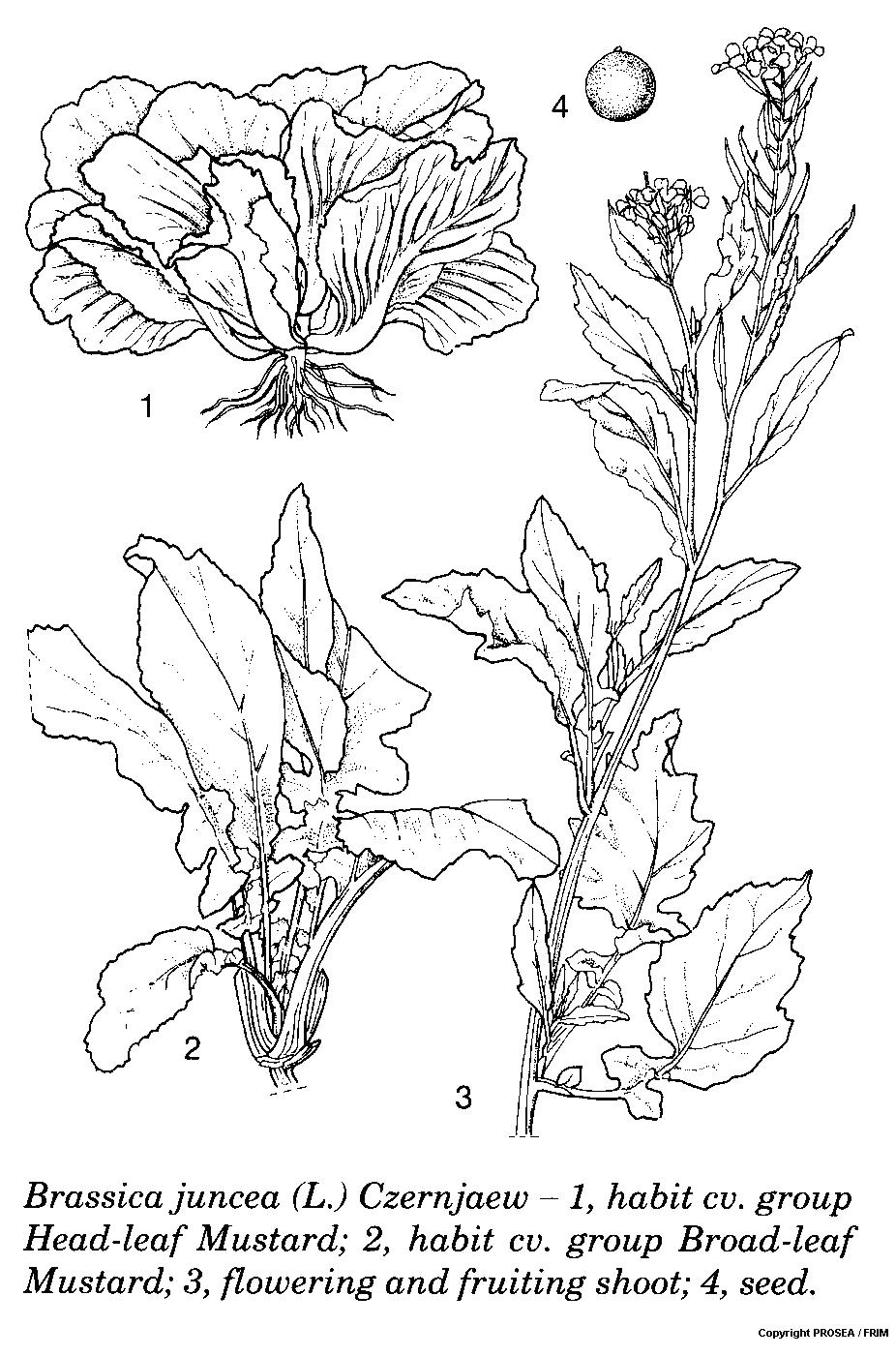Brassica juncea (L.) Czernjaew
Family
Cruciferae
Synonyms
Sinapis juncea L., Sinapis timoriana DC., Brassica integrifolia (West) Rupr.
Vernacular Names
| Malaysia | Sawi pahit, kai choy. |
| English | Indian mustard, Chinese mustard, vegetable mustard. |
| Indonesia | Sawi, sesawi. |
| Philippines | Mustasa (Tagalog). |
| Cambodia | Khat naa. |
| Laos | Kaad khièw. |
| Thailand | Phakkat-khieo, phakkat-khieopli (Central). |
| Vietnam | C[ar]i canh, c[ar]i b[ej] xanh. |
| French | Moutarde indienne, moutarde de Chine. |
Geographical Distributions
Brassica juncea crops are grown worldwide, from India to northern Africa, Central Asia (southern and south-eastern part of the former Soviet Union), Europe and North America. The exact origin is unknown, but as an amphidiploid it seems logical that it is originated in an area where the parental species, B. nigra (L.) Koch and B. rapa L., overlap in their distribution (e.g. Central Asia). It is generally agreed that the primary centre of diversity of B. juncea is Central Asia (north-west India, including the Punjab and Kashmir) with secondary centres in central and western China, Hindustan (East India and Burma) and Asia Minor (through Iran).
Two types of mustards with varying usage have evolved from B. juncea, i.e. oilseed types and vegetable types. The oilseed types (oilseed mustard) are particularly important in India, Bangladesh and China. The vegetable types comprise forms with edible leaves (leaf mustard), stems (stem mustard) and roots (root mustard). The vegetable mustards are widely cultivated in Asian countries. The highest degree of variation occurs in China, which is regarded as the primary centre of varietals differentiation. The early Chinese traders might have carried the crop into Southeast Asia, whereas the appearance of B. juncea near European ports suggests a connection with grain imports. It has also been suggested that the Indian contract labourers brought it to the west Indies. In Southeast Asia, the leaf mustards are most common.
Description
B. juncea is an erect annual to biennial herb that can grow up to 30-160 cm tall. It is normally unbranched but sometimes with long ascending branches in the upper part that is nearly smooth and nearly pale bluish-green. The taproot is sometimes enlarged (root mustard).
The leaves are very variable in shape and size, pinnate or entire, petioled, pale to dark green, smooth or pubescent and heading or non-heading.
The inflorescence is a corymbiform raceme, rather loose with numerous flowers and measures up to 60 cm long. The flowers are perfect. The ascending pedicel is 5-12 mm long. There are 4 green sepals that are oblong and measure 4-6 mm long. There are 4 petals that are clawed, obovate blade, measure 6-10 mm long and bright yellow. There are 6 tetradynamous stamens while the stigma is spherical.
The fruit is a silique (more than 3 times as long as broad), linear, sometimes inflated and often torulose, measuring 25-75 mm x 2-3.5 mm, attenuate into a conical beak, dehiscent and contains of 10-20 seeds.
The seed is spherical, brown to grey-black, measuring 1-1.5 mm in diametre and finely reticulated.
Ecology / Cultivation
B. juncea has the best tolerance to high temperatures and humidity among the allied species, providing a good supply of leafy greens when the cool season cabbages could not. It’s ecological complementarily with the cool season cabbages enabled mustard to develop as an important vegetable because it did not have to compete with the high-yielding crucifers such as Chinese cabbage. It has also basically determined the distribution of the two types. In the tropics, it is commonly grown in the cooler highland areas whereas the leaf mustards are widely grown in the lowlands. The leaf mustards grow best in fertile and well-drained loamy soils that are relatively rich in organic matter. As vegetables, B. juncea has a wide variation in flowering behaviour. The seeds are the most commonly grown cultivars that can be produced easily in the tropics, even under lowland conditions of the tropical fringes. Ordinarily, however, a good seed development requires moderately cool and dry conditions which are often obtained only at medium to high elevations in the tropics.
Line Drawing / Photograph
References
- Plant Resources of South-East Asia No. 8: Vegetables.



